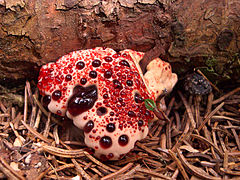Blue Shalite -- he flesh is 1–3 mm thick and has leathery texture. Older specimens, such as the one pictured, can have zones with green algae growing on them, thus appearing green. It commonly grows in tiled layers. The cap is rust-brown or darker brown, sometimes with blackish zones. The cap is flat, up to 8 x 5 x 0.5-1 cm in area. It is often triangular or round, with zones of fine hairs

It grows up the side of tree stumps and old deadfalls. It is known for its main ingredient in a health tonic and in stronger doses to reduce cancerous growths. Some take the tonic to prevent life threatening growths. It is an ingredient in the fabled life drink that is supposed to extend one’s life span. The exact recipe for that was lost centuries ago and is said the legend of the Life Juice comes from before the Voltaire. Many educated mages, scholars and advanced philterers have died attempting to locate, find and/or experiment on its creation.
The Land Barnacles -- The cap is shell-shaped, with the tissue concentrated at the point of attachment, resembling a stem. It is often wavy and lobed, with a rigid margin when old. It is tough, felty and hairy, and slippery when moist. It is greyish white and up to 4 cm in diameter. The gills are pale reddish or grey, very narrow with a longitudinal split edge which becomes inrolled when wet; the only known fungus with split gills that is capable of retracting by movement. It is found predominantly from spring to autumn on dead wood, in coniferous and deciduous trees. It has been known to grow from rotted wood in closed locations. This fungus will rot in humid and hot climate.

The land barnacle is usually not edible from when its picked. There is a method of extracting a property within the fungus that produces either deadly results or healing results depending on when its picked and how its cut. Only the practiced and experience can extract the properties from this fungus.
Demon’s Tooth – The mushroom/fungus at first displays a amalgous formation as the young specimens ‘bleed’ a red juice. Older specimens have a small base and a larger head looking like a flat tooth and range in color from eggshell, pale grey white to a light brown. It grows primarily from the root base of acid loving trees.

The extract from this fungus is anticoagulant and antibacterial.
The anticoagulant is procured from young specimens. The antibacterial is procured from older specimens that have already released its spores.


